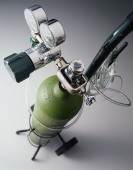
WEDNESDAY, Nov. 19, 2014 (HealthDay News) — Strapping an oxygen mask to someone suffering a heart attack might make their heart attack worse, new research suggests.
Heart attack victims treated with oxygen endured 25 to 30 percent more heart damage than patients not given oxygen, said lead investigator Dr. Dion Stub, an interventional cardiologist at St. Paul’s Hospital in Vancouver, Canada.
“This study backs up previous research that shows oxygen should be treated as a drug, and prescribed appropriately,” said Stub, who’s also a researcher at the Baker IDI Heart and Diabetes Institute in Melbourne, Australia. “If a heart attack patient’s oxygen levels are normal, you should not give them oxygen.”
The use of oxygen to treat heart attacks is almost a given, something ingrained from decades of practice, Stub said.
And, the practice makes logical sense — heart attacks occur when a blocked artery prevents oxygen from flowing to the heart. If the heart needs oxygen, then giving a person oxygen should help.
However, high levels of oxygen can cause the arteries to constrict and change blood pressure, according to Stub. High oxygen levels can also reduce the amount of blood pumped through the heart, and potentially increase damage to the heart muscle by increasing free radical production in cells, Stub said.
“They’re the exact things you don’t want to do to a person having a heart attack,” Stub said. “For example, you want to open the arteries, not constrict them.”
The results of this Australian clinical trial were scheduled to be presented Wednesday at the American Heart Association’s annual meeting in Chicago. Findings from meetings are generally considered preliminary until published in a peer-reviewed journal.
For the study, researchers had paramedics in Melbourne randomly assign heart attack patients to either receive or not receive oxygen during treatment. Lanyards hung around the patients’ necks by the ambulance crews let hospital workers know who should receive oxygen during the remainder of their care, and who should not.
The study included just under 450 heart attack patients. They had suffered heart attacks known as ST segment elevation myocardial infarction (STEMI), which is caused by a prolonged period of blocked blood supply.
In those who received oxygen, researchers found elevated levels of two enzymes that are released when the heart muscle is damaged, creatine kinase and troponin. The levels of these enzymes were 25 percent higher in those who were given oxygen compared to those who didn’t get oxygen, according to the study.
About a third of the participants returned six months following their heart attack to undergo a cardiac MRI, the “gold standard” for looking at heart damage, Stub said.
The MRIs revealed that people who got oxygen had 30 percent more damage to their heart muscle than those who did not, Stub said.
The researchers also found that oxygen made no difference in symptoms felt by the patients in their study — an unusual result, given that oxygen most often is provided during a heart attack because it is believed to reduce chest pain.
“They certainly felt no better,” Stub said. “There was no difference in pain.”
People given oxygen also had increased levels of complications, including repeat heart attacks, major bleeding and irregular heart rhythms, he said.
Death rates six months after treatment were similar — 3.8 percent for patients with oxygen and 5.9 percent for those who did not receive oxygen, according to the study.
Stub recommended a larger follow-up trial that looks at death rates as well as the amount of heart damage.
Dr. Clyde Yancy, chief of cardiology at the Northwestern University Feinberg School of Medicine in Chicago, applauded the researchers for challenging conventional wisdom.
“It demonstrates things we commonly do may not be effective, and in fact may cause harm,” Yancy said. He added that unless the patient’s oxygen levels are low, “there doesn’t seem to be any good reason to use supplemental oxygen when treating heart attack patients.”
But Yancy also noted that the oxygen used on the Australian patients is higher than levels typically provided to patients in U.S. hospitals, which might complicate how the results apply here.
Stub disagreed, saying that paramedics around the world usually provide oxygen at much higher levels than those at hospitals.
“What they’re doing in the hospital is different from the medics,” he said.
More information
For more on heart attack, visit the U.S. National Institutes of Health.
Copyright © 2025 HealthDay. All rights reserved.

